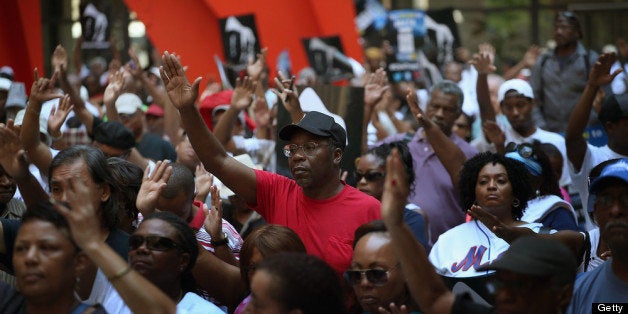
This article is part of a Huffington Post series examining the state of Black America. To read more, click here.
The death of Trayvon Martin and subsequent acquittal of George Zimmerman has given rise to particularly cynical, pessimistic public discourse about race, crime, and violence in America.
Civil rights leaders and progressive activists have cited Zimmerman's acquittal and the proliferation of robust self-defense laws as evidence of a "war on black men" -- or, similarly, that it's now "open season on black men." Meanwhile, Zimmerman supporters and many on the political right have used the case to bring up old discussions of black-on-black murders in places like Chicago, and to argue that violence in black America is spiraling out of control. Both positions are cynical, and both tend to pit black and white America against one another.
But both are also wrong on the facts.
First, about the alleged "war on black men." The argument here is that laws like Florida's "Stand Your Ground" are encouraging white vigilantism, and moving white people to shoot and kill black people at the slightest provocation. But there just isn't any data to support the contention. Black homicides have been falling since the mid-1990s (as have all homicides). Moreover, according to a 2005 Bureau of Justice Statistics report, more than 90 percent of black murder victims are killed by other black people. And if we look at interracial murder, there are about twice as many black-on-white murders as the other way around, and that ratio has held steady for decades.
However, it also isn't true that black America is growing increasingly violent. Again, black homicides, like all homicides, are in a steep, 20-year decline. In fact, the rates at which blacks both commit and are victims of homicide have shown sharper declines than those of whites. It's true that Chicago has had an unusually violent last few years, but this is an anomaly among big American cities. The 2012 murder rate in Washington, D.C., for example, hit a 50-year low. Violent crime in New York and Los Angeles is also falling to levels we haven't seen in decades.
The odd thing is, even in the face of encouraging data, media outlets still manage to find ways to make people afraid. One good example is this 2012 Scripps Howard study of interracial crime, which ran in 2012 just as racial tension was heating up over Martin's death. The news service analyzed 30 years of data on interracial homicide. The resulting headline: "Interracial murder rate growing in U.S." The problem is that the data shows precisely the opposite.
To get to the more sensational conclusion, the article considers interracial homicide as a percentage of total homicides. And indeed, measured that way the "rate" of interracial murder has gone up. But it's an odd way to measure. The vast, vast majority of murders are intraracial. And, as noted, those murders have been dropping considerably. The interracial murder rate has been dropping, too. According to the Scripps Howard review, the raw number of black-on-white and white-on-black murders combined was about the same in 2010 as it was in the early 1980s. But the United States population has grown considerably in that time, from 227 million in 1980, to 315 million today. So if you measure it the way all other crime is measured, the interracial murder rate has dropped, not increased.
It is true that the rate of interracial crime hasn't dropped nearly as much as intraracial crime. Why might that be? Believe it or not, the news here is encouraging, too.
We aren't seeing the same rate of progress with interracial killings as we're seeing in the overall murder rate because the country is becoming more integrated. That's a good thing. You're much more likely to be killed over someone you know than by a stranger. So as blacks and whites are increasingly living together and interacting, there are more opportunities for feuds over money, love, and whatever other sorts of quarrels lead to violence. This, too, is suggested in the data: "In the 1980s, about 47 percent of white-on-black killings occurred between people who were strangers. That figure dropped to 40 percent since 2000." So not only is the rate of interracial killing going down, the rate of interracial killing among strangers -- murders more likely to be brought about by raw racism -- is dropping even faster.
The Scripps Howard piece also takes a regional approach: "Contrary to popular stereotypes, interracial killings are relatively rare in rural Deep South states, occurring at a rate well below the national average. Several crime experts agreed this rise reflects increasing social contact between Americans of different races occurring in many, but not all, communities."
We tend to be cynical about crime -- even when there's no direct evidence in front of us -- that it's getting worse. Over the years, polls have consistently shown that most Americans think crime in general is getting worse, but feel perfectly safe in their own neighborhoods. Polls also continue to show that a solid majority of Americans think crime is getting worse, even though the crime rate has been in a 20-year free fall.
That pessimism, likely driven by the media's tendency to focus on sensational crimes and to interpret even positive data in ways the most alarming way possible, is one reason why we continue to get tough-on-crime policies from politicians, soaring incarceration rates, and it's why it's so difficult to get legislators to revise or repeal laws that that may have gone too far.
But when you add race to the equation, that pessimism can quickly become destructive. If black people are continually told that self-defense laws are creating a class of white vigilantes, in spite of all evidence to the contrary, they'll begin to view white people with more suspicion. If white people are regularly told that black America is growing more violent, in spite of all evidence to the contrary, they'll begin to view black people with more suspicion.
None of this is to say that there isn't still racism in America. And when you look at policies like New York's stop-and-frisk program, or the fact that blacks are arrested for drug crimes at much higher rates than whites despite similar rates of drug use, you could make a strong argument that at least with respect to the criminal justice system, there really is a war on young black men.
It's natural that the Martin/Zimmerman tragedy would be viewed through that lens, and in the context of America's turbulent racial history. But it's also important to point out that a single incident, or even a few incidents, are not indicative of a trend. Race relations in America aren't perfect, but they are improving. The worst possible legacy for Martin would be if the false claims about racial violence and animosity in America that have been made in light of his death were to become self-fulfilling.
